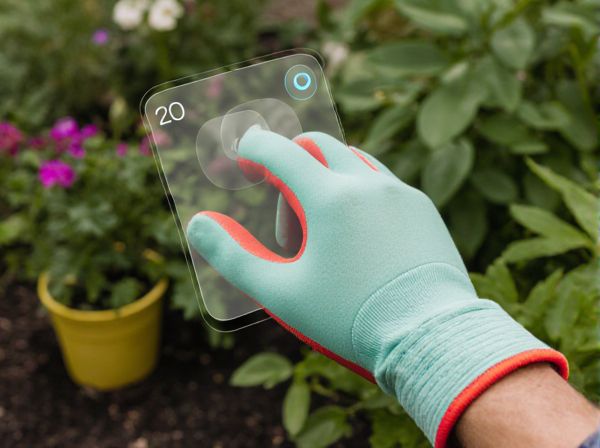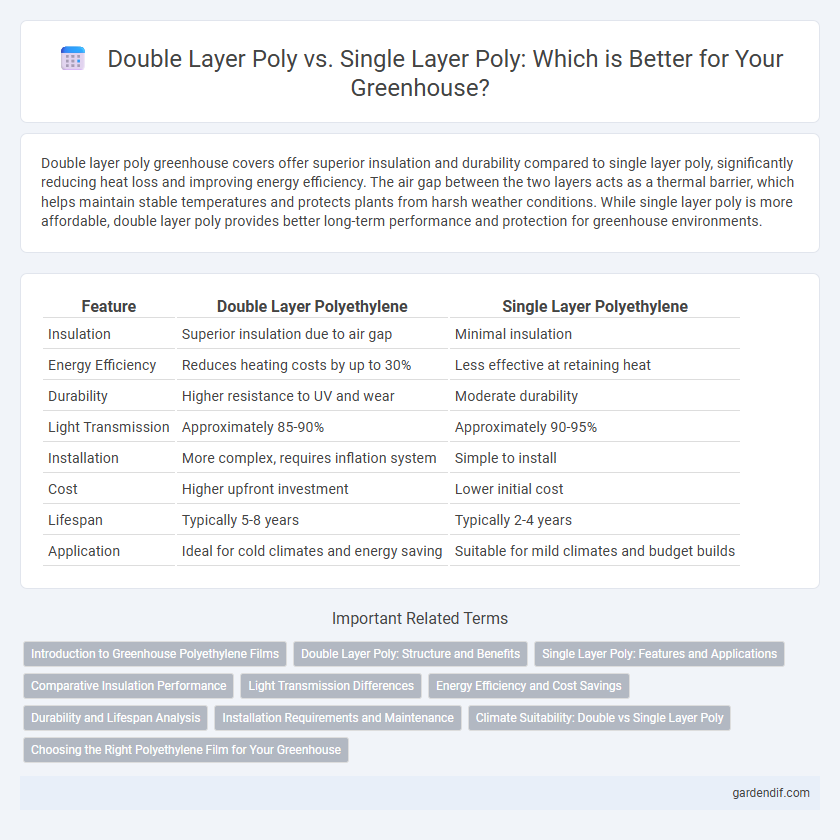
Double Layer Poly vs Single Layer Poly Illustration
Double layer poly greenhouse covers offer superior insulation and durability compared to single layer poly, significantly reducing heat loss and improving energy efficiency. The air gap between the two layers acts as a thermal barrier, which helps maintain stable temperatures and protects plants from harsh weather conditions. While single layer poly is more affordable, double layer poly provides better long-term performance and protection for greenhouse environments.
Table of Comparison
| Feature | Double Layer Polyethylene | Single Layer Polyethylene |
|---|---|---|
| Insulation | Superior insulation due to air gap | Minimal insulation |
| Energy Efficiency | Reduces heating costs by up to 30% | Less effective at retaining heat |
| Durability | Higher resistance to UV and wear | Moderate durability |
| Light Transmission | Approximately 85-90% | Approximately 90-95% |
| Installation | More complex, requires inflation system | Simple to install |
| Cost | Higher upfront investment | Lower initial cost |
| Lifespan | Typically 5-8 years | Typically 2-4 years |
| Application | Ideal for cold climates and energy saving | Suitable for mild climates and budget builds |
Introduction to Greenhouse Polyethylene Films
Greenhouse polyethylene films are essential for controlling environmental conditions and promoting plant growth. Double layer poly films provide superior insulation and durability by trapping air between the two layers, reducing heat loss and condensation compared to single layer poly films. Single layer poly films are more economical but offer less protection against temperature fluctuations and mechanical damage.
Double Layer Poly: Structure and Benefits
Double layer poly greenhouse coverings consist of two layers of polyethylene film separated by an air gap, enhancing insulation and reducing heat loss compared to single layer poly. This structure creates a thermal barrier that improves temperature regulation, conserves energy, and protects plants from extreme weather conditions. The double layer system also minimizes condensation buildup, promoting healthier plant growth and extending the growing season.
Single Layer Poly: Features and Applications
Single layer polyethylene (poly) in greenhouses offers reliable light transmission and cost-efficiency, making it suitable for diverse agricultural environments. Its lightweight and flexibility enhance installation and maintenance, while UV protection extends durability against sun damage. Commonly applied in commercial and hobby greenhouses, single layer poly supports optimal plant growth by maintaining temperature and humidity control.
Comparative Insulation Performance
Double layer poly greenhouse covers provide superior insulation compared to single layer poly by trapping an air cushion between the layers, significantly reducing heat loss. This enhanced thermal barrier maintains a more stable internal temperature, promoting better plant growth and extending the growing season. Single layer poly, while more affordable, offers less protection against temperature fluctuations and heat escape.
Light Transmission Differences
Double layer poly greenhouse covers provide superior insulation by trapping an air gap between the layers, yet they slightly reduce light transmission compared to single layer poly, typically allowing around 80-85% of natural light. Single layer poly offers higher light transmission, generally exceeding 90%, which benefits photosynthesis and plant growth but lacks the thermal retention of double layers. Choosing between them depends on balancing the need for maximum light exposure against energy efficiency and temperature control in greenhouse environments.
Energy Efficiency and Cost Savings
Double layer poly greenhouse coverings provide superior energy efficiency compared to single layer poly by creating an insulating air pocket that reduces heat loss, leading to lower heating costs. The enhanced thermal retention in double layer systems can cut energy expenses by up to 30%, making them a cost-effective choice for year-round crop production. Although the initial investment is higher, the long-term savings on energy and improved plant growth yield a faster return on investment.
Durability and Lifespan Analysis
Double layer polyethylene greenhouse covers offer significantly enhanced durability and lifespan compared to single layer poly, providing better resistance to tearing, UV degradation, and weather fluctuations. The two layers create an insulating air pocket that reduces temperature stress and prevents material fatigue, extending effective use up to 5-7 years versus 2-3 years for single layer covers. This improved structural integrity and thermal regulation lead to lower maintenance costs and more consistent growing conditions throughout multiple growing seasons.
Installation Requirements and Maintenance
Double layer polyethylene greenhouse coverings require a more complex installation process, involving inflation systems to maintain the air cushion between layers, which enhances insulation but demands precise setup and regular air pressure monitoring. Single layer polyethylene is simpler to install, needing only basic framing and fastening, resulting in lower initial labor and equipment costs but reduced thermal efficiency. Maintenance for double layer poly includes routine checks for leaks and maintaining inflation systems, while single layer poly mainly involves inspecting for tears and replacing damaged areas to ensure durability.
Climate Suitability: Double vs Single Layer Poly
Double layer poly offers superior insulation compared to single layer poly, maintaining stable temperatures ideal for colder climates and extending the growing season. Single layer poly is more suitable for mild, temperate climates where extreme temperature fluctuations are less common, providing sufficient protection and allowing better light transmission. The choice directly impacts energy efficiency, plant health, and overall greenhouse performance based on regional climate conditions.
Choosing the Right Polyethylene Film for Your Greenhouse
Selecting the right polyethylene film for your greenhouse significantly impacts temperature regulation and durability. Double layer poly offers superior insulation by trapping air between layers, reducing heat loss and enhancing energy efficiency, making it ideal for colder climates. Single layer poly is more cost-effective and easier to install, suitable for mild conditions where budget constraints are a priority.
Double Layer Poly vs Single Layer Poly Infographic

 gardendif.com
gardendif.com